mobile View, to the German Version tap the flag


- Gorizia and Gradisca (Görz und Gradisca)
- former component of the Austrian-Illiric Littoral
- former Austrian crown land: Princely County of Gorizia and Gradisca
- situated to the left and to the right of Isonzo River in the Julic Alps
- own name in German: Gefürstete Grafschaft Görz und Gradisca
- own name in Italian: Principesca Contea di Gorizia e Gradisca
- own name in Slovene: Poknežena grofija Goriška in Gradiščanska
• Flag
• Meaning/Origin of the Flag
• Coat of Arms
• Meaning/Origin of the Coat of Arms
• Map of the crown lands of the Littoral
• Map of the former crown lands of Austria-Hungary (to 1918)
• Numbers and Facts
• History
• historical Maps
• Origin of the Country's Name
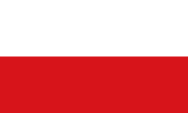
Gorizia and Gradisca
1861–1919,
Flag of the country (Colours of the country),
ratio = 2:3,
Source, by:
Flags of the World



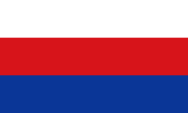
Görz/Gorizia
Flag of the country (Colours of the country),
ratio = 2:3,
Source, by: Flags of the World



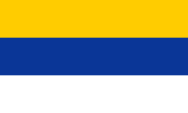
Gradisch/Gradisca
Flag of the country (Colours of the country),
ratio = 2:3,
Source, by: Flags of the World





The country had – like all the other crown lands of the Austrian crown – its own colours (Landesfarben), which were used amongst others on horizontally two- or three-striped flags. The colours (Landesfarben) were very often taken from the respective coat of arms of the country or were supplemented by another colour, which not appears in the coat of arms, or they went back to older models of the coat of arms (e.g. Carniola). Officially, the colours had never been regulated or stipulated, so that their sequence varied in practice or even the colors deviated. The Austrian heraldist Hugo Gerard Ströhl (1851–1919) was probably the first to take care of it and asked for the colors (Landesfarben) on the flags at the respective state authorities around 1890 and compiled them.
The Crown Land "Princely County of Goerz und Gradisca", formed in 1861, used as colours of the country a flag which showed two horizontal stripes in white and red. The colours descend from the coat of arms of Goerz which showed among other six stripes in white and red. The colors white and red could also be a compromise solution, because:
Gradisca was separated from the old County of Gorizia between 1500 and 1516, and then again between 1647 and 1717. At least in the latter case it was combined with an own coat of arms, which has been similarly preserved up to the present days. During the time of the Habsburg monarchy, the coat of arms showed a between gold and blue parted per fess (halved horizontally) shield and in the middle a silvery anchor cross, what finally means the colours: gold, blue and silver. Some sources refer to these colours as the colours of Gradisca (Landesfarben), but they are not verified anywhere. During the time of the Habsburg monarchy, the coat of arms of the County of Gorizia (Goerz) was parted per bend (diagonally from upper left to lower right), and showed a crowned golden lion on blue above the diagonal and six stripes in silver and red, what finally means the colours: silver, red and blue. Some sources refer to these colours as colours of Gorizia (Landesfarben), but they are not verified anywhere.
The colours of Gorizia and Gradisca are not so much the problem, but rather the fact that both parts of the country probably both had their own colours. There are many possible color combinations here, all related to the colors of the coat of arms, which are all seem given as the colors for the parts of the country. Assuming that it is true that Gorizia and Gradisca had their own colours (actually a process that was completed in the German interior lands not until 1830), the colours white and red could be a compromise for the "Princely County of Gorizia and Gradisca", because each one of the two colours appears in the respective coat of arms, or also in the colours (Landesfarben). Supposedly, the above mentioned colors could have been used legally in the both parts of the country in addition to white and red until 1918.
Source: Österreichisch-Ungarische Wappenrolle,
Flags of the World,
Volker Preuß


Blazon of Gorizia und Gradisca,
Source, by:
Flags of the World
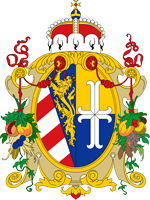
ca.1890–1918,
Coat of arms of the Princely County of Gorizia und Gradisca,
Source, by: Ströhl, Wappenrolle Österreich-Ungarns, 1890, via Wikipedia (D)

Blazon of the County of Gorizia,
Source, by:
Wikipedia (D)

Blazon of Gradisca,
Source, by:
Österreichisch-Ungarische Wappenrolle

The coat of arms of the "Princely County of Gorizia and Gradisca" shows a parted per pale shield, the coat of arms of Gorizia in front, in front parted per bend, a golden crowned golden lion in blue above, below five times in silver and red parted per bend sinister, in the back the coat of arms of Gradisca, a silvery anchor cross in a gold over blue parted per fess field. The shield wears a princely hat. The coat of arms of Gorizia goes back to the house of the Meinhardiner. They are also were called "Görzer" (House of Gorizia). The Austrian heraldist Hugo Gerard Ströhl surrounded the coat of arms ca. 1890, in its last known version, with for the country typical fruits, to emphasize the importance of the country as a agricultural and fruit-growing region. You can see corn, pomegranates, wine and cherries.
Source: Österreichisch-Ungarische Wappenrolle,
Wikipedia (D),
Volker Preuß

Map ca. 1910:
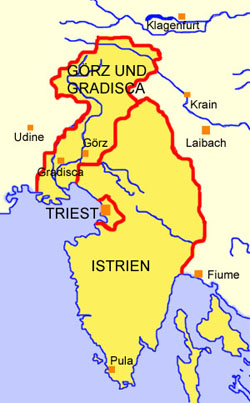
Source: Volker Preuß

Map ca. 1910:
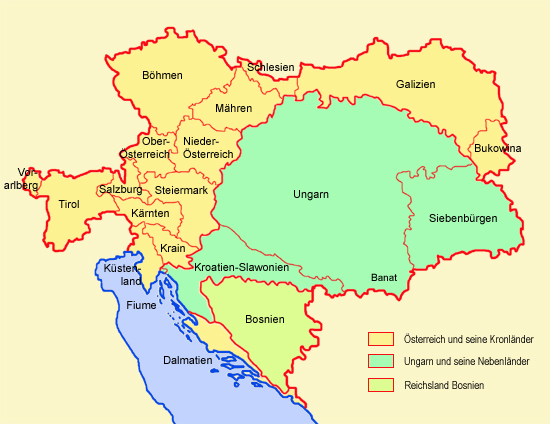
Source: Volker Preuß

Area: 1.127 square miles (1900)
Inhabitants: 232.900 (1900), thereof 60% Slovenes, 34% Italians, 2% Germans
Density of Population: 207 inh./sq.mi. (1900)
Capital: Görz (today's Italian name: Gorìzia), 21 000 inh. (1880), 34.336 Ew. (2018)
Sprachen (1900): Slovanian, Italian, German
Time Zone: GMT + 1 h
Source:
Wikipedia (D)

ca. 80 B.C. · the conquest of the region by the Roman Empire is finished, to the province of Italia
395 · at the partition of the Roman Empire the region comes to the West Roman Empire (Rome)
476–489 · the region belongs to the Empire of the Odoaker
489–553 · the region belongs to the Empire of the Eastern Goth
6th cent. · settlement by Slavic tribes
569–598 · conquest by the Pannonian Avars
ca. 800 · the region becomes subjected by the Frankish Empire of the Carolingians, the region comes to the Margraviate of Friaul
9th cent. · the Margraviate of Friaul comes to the new established Margraviate of Verona
952 · the Margraviate of Verona comes to Bavaria
976 · the Margraviate of Verona comes to the Duchy of Carinthia
10th/11th cent. · the region comes in influence of the Patriarchs of Aquileia
12th cent. · the County of Gorizia (Goerz) becomes independent from the Patriarchate of Aquileia under the Counts of Gorizia (Goerz)
1286 · the House of Gorizia earns the Duchy of Carniola
1335 · Vanish of the House of Gorizia (younger lineage) in Carinthia
1363 · Vanish of the House of Gorizia (younger lineage) in Tyrolia
1500 · Vanish of the older lineage of the House of Gorizia, the County of Gorizia comes as inheritance to the House of Habsburg, there are disputes with Venice, which claims Gradisca
1516 · Peace of Brussels, Venice cedes Gradisca to the House of Habsburg
1647 · Emperor Ferdinand III. separates Gradisca from the County of Gorizia and gives it as a fiefdom to the house of Eggenberg as Princely County of Gradisca (German: Gradis or Gradisch)
1717 · the Eggenbergers die out, the fief goes out and is retracted, Gorizia and Gradisca are united to the Princely County of Gorizia and Gradisca
1797–1809 · French Revolutionar Wars, parts of Austria (Styria) become occupied by the French in 1797
1809 · Peace of Vienna, Austria loses Salzburg, the Inn Quarter, Western Galicia and parts of Eastern Galicia and cedes Istria, Trieste, Gorizia, Carniola, Carinthia, Croatia, and Dalmatia to France, which were merged in 1810 to the French "Illyrian Provinces"
1813 · Austria declares war on France (Napoléon)
1814/1815 · Congress of Vienna, realignment of Europe after the era Napoléon, the Empire of Austria (House of Habsburg) acquires back the in 1809 lost territories; Istria, Trieste, Gorizia, Carinthia and Carniola become merged to the Habsburg's Kingdom of Illyria, Dalmatia and Croatia become re-annexed to Hungary (under the Habsburgs, part of the Empire of Austria)
1848/1849 · revolution in Vienna, civil war between Hungarians and Croats, riotings in Prague, Mailand and Venice, as a result of that Emperor Ferdinand I. resigns and Franz Joseph I. of Habsburg becomes new Emperor, the riotings become suppressed and he enacts a new constitution: the titular hereditary territories of the Habsburgs in the Austrian Empire become converted to crown lands with their own Landtag (parliament), the Landtag of Dalmatia rejects the annexion to Croatia, the Kingdom of Dalmatia becomes an own crown land of the Austrian crown, Croatia and Slavonia become united to the "Kingdom of Croatia and Slavonia", which remains as a subsidiary country under the Hungarian crown, dissolution of the Kingdom of Illyria: division in the crown lands of Carniola, Carinthia, Littoral, Croatia and Slavonia and Dalmatia
1861 · new Austrian constitution, the three components of the Littoral, Margraviate of Istria, Princely County of Gorizia and Gradisca and the Imperial Free City of Trieste and its surrounding area, become own crown lands with their own parliaments, but under a common head of state, the governor of the Austrian-Illiric Littoral with his seat in Trieste
1914–1918 · First World War, thereafter breakdown of the imperial-royal monarchy, disintegration of Austria-Hungary in national states
10th of September 1919 · Treaty of Peace of Saint-Germain after the First World War, Austria has to cede Gorizia and Gradisca to Italy, affiliated to Italy as "Provincia di Gorìzia"
1945 · conquest and occupation of the area by Yugoslav partisans at the end of the Second World War, expulsion and partially even assassination of the largest part of the in the country remained German civilian population
1947 · as a result of the 2nd World War Italy has to cede ca. 85% of the territorry of the "Provincia di Gorìzia" to Yugoslavia (nowadays Slovenia), partition of the City of Gorizia
Source: Atlas zur Geschichte,
Wikipedia (D),
RetroBib Retrobibliothek,
Discovery '97,
Volker Preuß

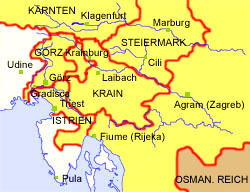
ca. 1526
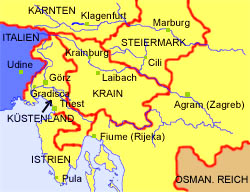
1849
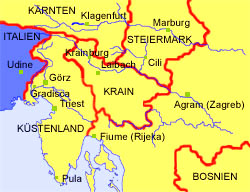
1880
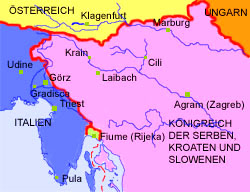
1921
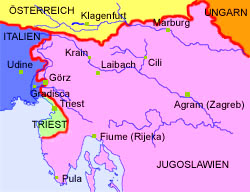
1950
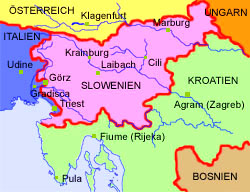
2005
Maps: Volker Preuß

The name of the town of Gorizia, the seat of the Counts of Gorizia from the House of the Meinhardiner, comes from the Slavic word "gorica", what means "little hill". Gorizia is called "Gorizia" in Italian, in Slovenian "Gorica" in Furlanic "Gurize" and in English also "Gorz or Goerz". The name of the town of Gradisca comes from the Slavic word "gradec", which means "little castle". The Italian name of the town, "Gradisca", is "Gradis or Gradisch" in German, "Gradišče" in Slovenian, "Gardiscja or Gardiscje" in Furlan and "Gradisca" in English.
What is a Princely County? A county is ruled by a count. A count is usually subordinated to a higher noble, e.g. a duke - the county is therefore part of a duchy. In contrast to the count, a duke belongs to the nobility as imperial prince, is directly subordinated to the emperor and has access to the imperial prince's council, which advises the emperor. However, the emperor was able to elevate a count to the rank of an imperial prince, without that he received a new and higher title. He had access to the imperial prince's council and was called "princely count" or "imperial count".
Source: Handbuch der geographischen Namen,
Wikipedia (D),
Volker Preuß

Further Austria pages (historical flags and coats of arms):
• Empire of the Austrian Habsburgs (to 1804)
• Empire of Austria (1814–1867)
• Austria-Hungary (1867–1918)
• Republic of Austria (since 1918)

![]()






















